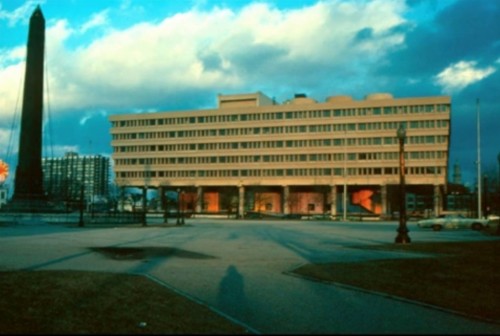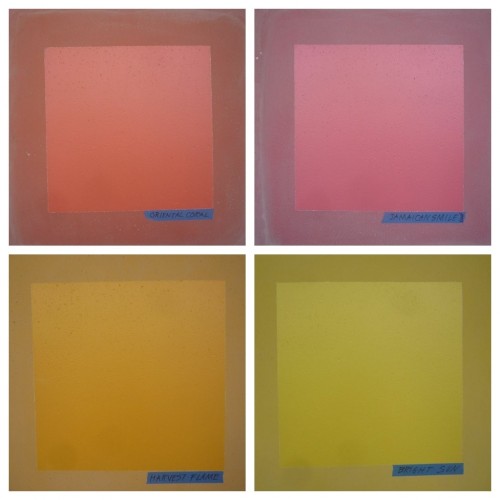
1975 Minton-Capehart Federal Building with Milton Glaser's mural, "Color Fuses." Image Evans Woollen.
In 1975 the Brutalist-inspired Minton-Capehart Federal Building opened in Indianapolis with a 27-foot tall, polychromatic artwork, Color Fuses, completely wrapping its loggia. This 672-foot mural has 35 bright fields of color that fade into each other, and a complex lighting system for the evening. Legendary designer Milton Glaser created Color Fuses with the idea that he wanted to make “a mural that would express a spirit of openness and thus a new sense of government.”
The project was commissioned through the U.S. General Services Administration’s Art (GSA) in Architecture Program. Glaser was selected to design this site-specific project and worked with the building’s architect, Evans Woollen, who hoped that Color Fuses would make the building “cheerful, disarming, fresh, welcoming, and inviting.”
While it’s always been clear how the artwork was to be viewed during daylight hours, originally it was designed with a complex lighting system that was supposed to gradually illuminate the bands of color in a kind of programmed wave sequence during evening hours. The light-dimming system fell out of operation shortly after it was installed, and later was replaced with fixed illumination. Adding to the technical difficulties of this system, in 1975 the primary lighting source was incandescent light bulbs, which produce a yellowish light that can affect the way color is perceived, particularly when dimmed at low wattage. The original system also did not create an even wash of light on the wall, which caused a scalloped appearance on the mural.
In 2009, President Obama’s American Recovery and Reinvestment Act provided $50 million to restore and modernize the Minton-Capehart Federal Building, and also funds to restore the Glaser’s artwork. The art restoration project was overseen by Caroline Sachay, Regional Fine Arts Officer for the GSA’s Fine Arts Program.

During restoration, view of the north west wall of Milton Glaser's mural "Color Fuses," 1975. Image by Mark Williams, Imagenation, LLC. Property of the U.S. GSA.
“When we started the restoration we were at a point in which the artwork almost had disappeared and it couldn’t be properly interpreted,” said Sachay. “The colors were faded to a dirty pastel and the programmed lighting system wasn’t working. Glaser’s simple yet inspiring gesture was very much lost.”
Martin Radecki, a conservation consultant based in North Carolina and the former Chief Conservator at the Indianapolis Museum of Art, was hired to identify all of the original colors used on the mural and to come up with a plan to create a new lighting system based on Glaser’s original concept and intentions. Radecki’s recommendations became the guide for work to be completed by the paint and lighting specialists.
The Minton-Capehart Building, which Woollen himself says “so many people love to hate,” has always been misunderstood and under-appreciated in the city; likewise Color Fuses hasn’t been well-understood or appreciated in Indianapolis (partly because of its condition).
“We knew early on that it was going to take a major team effort to get the artwork properly restored,” said Sachay. “The artist, conservators, architects, lighting designers, painters, and GSA team that participated in the project took pride in their roles and extended an extra effort knowing that this is an important work of art, one that is highly visible in downtown Indianapolis, and part of our National Fine Arts Collection.”
A few Indianapolis publications have been paying attention to the restoration project, including the Indianapolis Star, Indianapolis Monthly, and Indianapolis-based artist and blogger, Nathaniel Russell, who runs the blog Crooked Arm.

During restoration, view of the north wall of Milton Glaser's mural "Color Fuses," 1975. Image by Mark Williams, Imagenation, LLC. Property of the U.S. GSA.
Like many conservation projects, this one turned out to be a bit more complicated than first imagined. “Not only were the colors badly faded, but in some parts they were coated with a polyurethane varnish that itself had yellowed badly and become very dirty, and some parts had been over painted with the wrong colors,” said Radecki. “This made the first part of our project to identify the 35 colors a little tricky.”

During restoration, view of the west wall of Milton Glaser's mural "Color Fuses," 1975. Image by Mark Williams, Imagenation, LLC. Property of the U.S. GSA.
Radecki worked with an Indianapolis-based crew of paint specialists to perform cleaning tests of the paint in order to identify each of the original paints used for the 35 bands of colors. He also helped determine how each of the colors was originally feathered into the others.
Eventually Radecki and his crew were able to identify all 35 colors and painted them out on sample cards that he took to Glaser in his New York studio. “Milton was very helpful; he looked at all of the cards we made and thought everything that I brought was correct, except for one color. He adjusted that one and then we had our colors,” said Radecki, who then took these colors back and had 35 samples painted in squares for each color of the mural.

Color tests for "Color Fuses" by Milton Glaser. Images by Nathaniel Russell.
Radecki’s color guidelines and recommendations were turned over to Thomas Moore Studios, a design and architectural finishes firm based in Baltimore, MD. Working at night, when the building was closed, Thomas Moore Studios completely re-painted all 35 color bands, spending considerable time to make sure each color fade was correct and in tune with the rest of the mural.

Painters from Thomas Moore Studios re-painting "Color Fuses" by Milton Glaser, May 2012. Image by Caroline Sachay.
“There was a certain amount of interpretation in our work in order to get the fades correct,” said Thomas Moore, of Thomas Moore Studios. “Certain aspects of the fades were different from color to color so some areas lent themselves for a broader, and others had a more defined fade.”

After restoration, view of the west wall of Milton Glaser's mural "Color Fuses," 1975. Image by Mark Williams, Imagenation, LLC. Property of the U.S. GSA.
Moore and his crews worked in a number of late-night sessions from mid-April to June to complete the re-painting of the mural. “I hope the paint will last for at least 35 years,” concluded Moore.

After restoration, view of the west wall of Milton Glaser's mural "Color Fuses," 1975. Image by Mark Williams, Imagenation, LLC. Property of the U.S. GSA.
While the paint was being sprayed out, Fisher Marantz Stone (FMS) was re-working and installing the new lighting system. With Glaser’s input, they were able to create an LED lighting system that could finally produce the kind of programmatic lighting display that was originally intended by the artist.
“As it had been out of operation for so long, the night illumination was a forgotten part of the work, but just as essential as the color. We worked closely with the lighting designer, performing on-site mockups and tests to ensure an even wash of light on the wall and to balance the temperature of the LEDs so that they would accurately render Glaser’s colors.”
To understand how well the new lighting system works, you really have to see Color Fuses in person. In the evening, the building’s entire loggia is encircled in light coming from the LED lamps. The building vibrates with color. If you watch closely, you see a wave of bright light slowly moving around the building, illuminating the bands of colors and then going dark. As the light washes over each color, they seem to come a little bit more alive.
It all moves at about the pace of someone walking slowly past the building. The effect is impossible to fully capture in still photos, but can be understood better through video. The GSA has a page dedicated to the project, complete with a very good video.
“Now that Color Fuses is restored, our hope is that Indianapolis will embrace the mural and find a renewed respect for the work,” said Sachay. “It is a unique work within Mr. Glaser’s portfolio and the result of a highly successful collaboration between artist and architect.”

After restoration, night view of the north west wall of Milton Glaser's mural, "Color Fuses," 1975. Image by Mark Williams, Imagenation, LLC. Property of the U.S. GSA.




Pingback: Artwork foot | Janetbosshart
Pingback: I AM A CITIZEN OF NO MEAN CITY vol. 2 : Bad at Sports